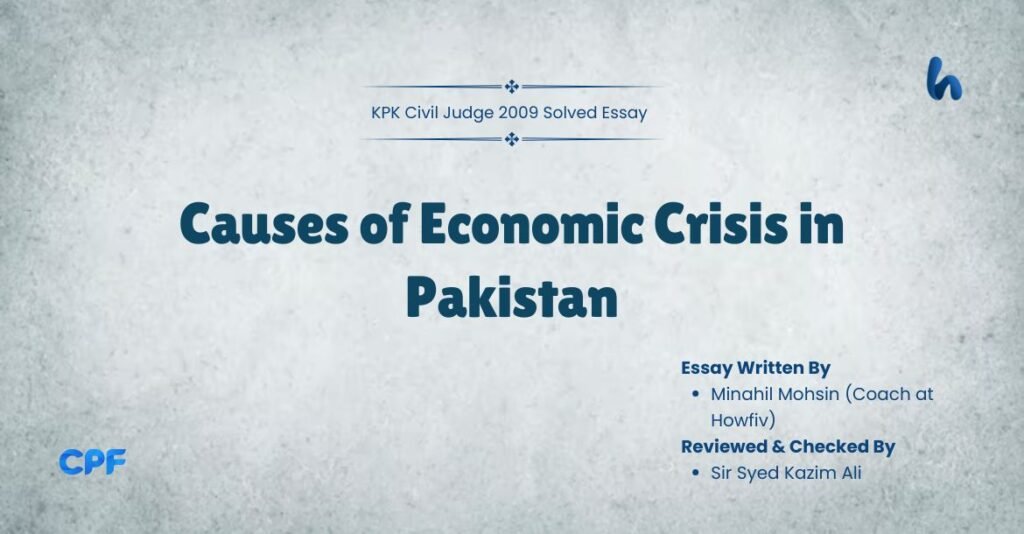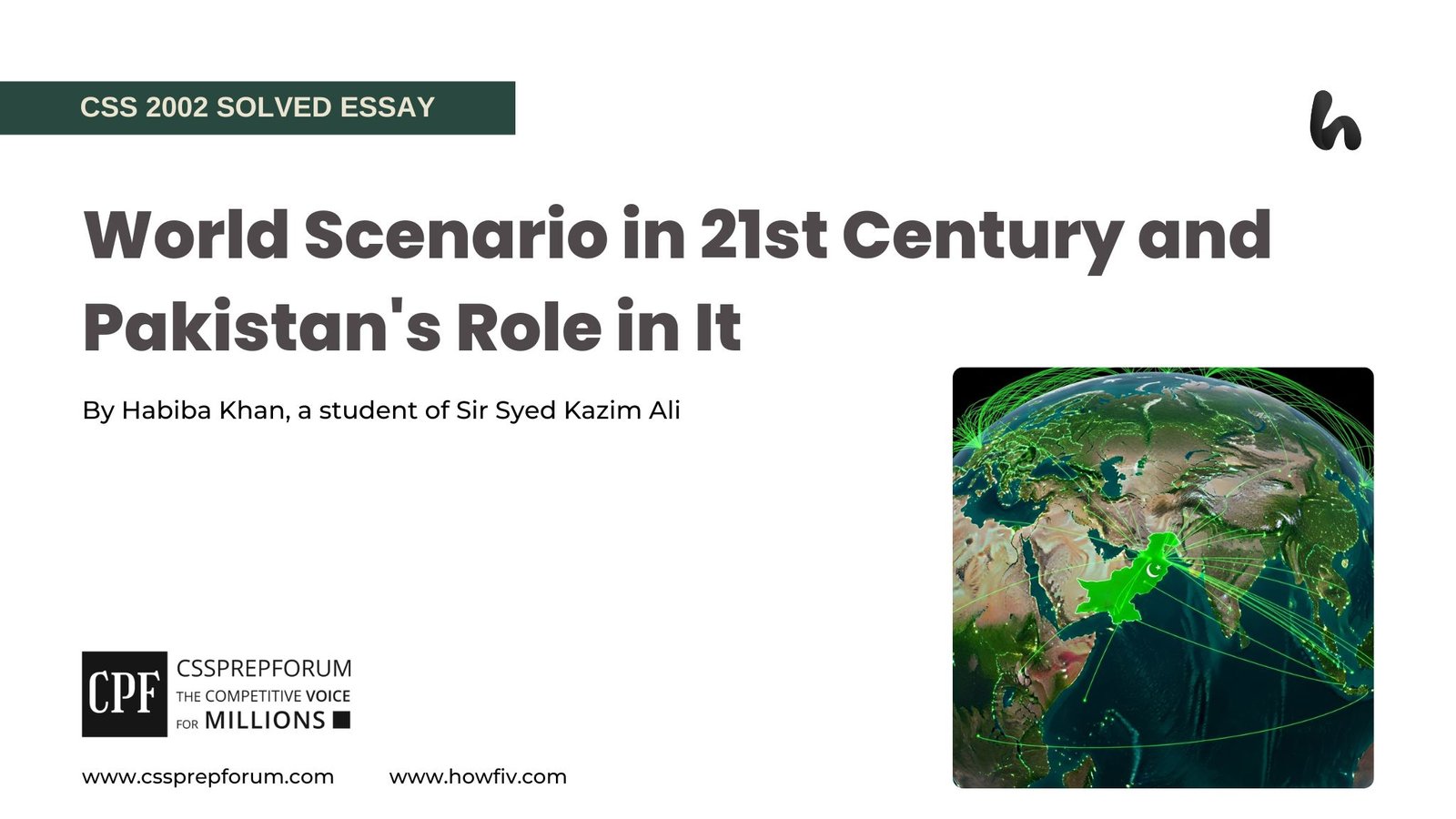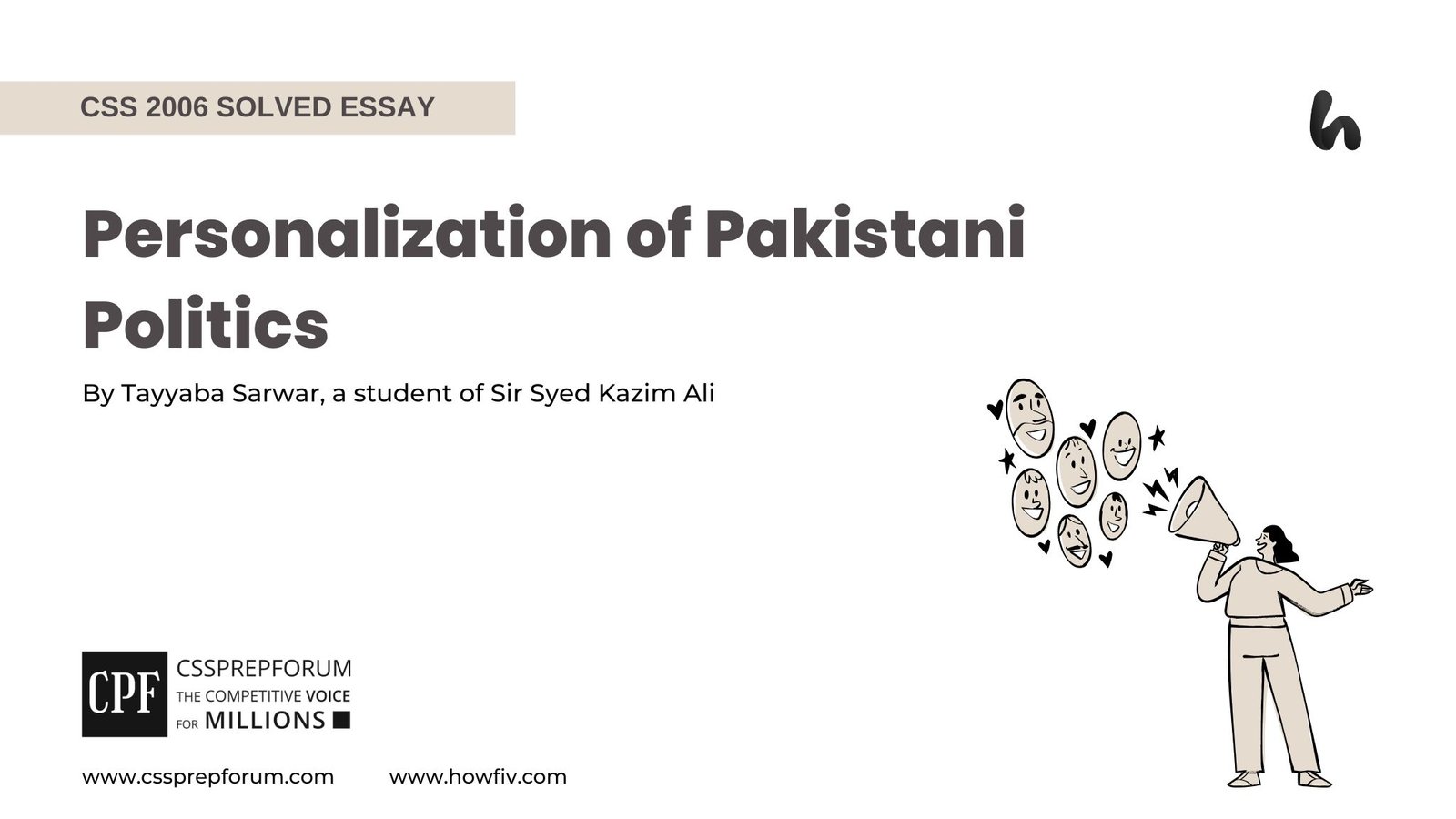Minahil Mohsin, a Sir Syed Kazim Ali student, has attempted the Civil Judge KPK 2009 Five Paragraph Essay “Causes of Economic Crisis in Pakistan“ on the given pattern, which Sir Syed Kazim Ali teaches his students. Sir Syed Kazim Ali has been Pakistan’s top English writing and CSS, PMS essay and precis coach with the highest success rate of his students. The essay is uploaded to help other judiciary and competitive aspirants learn and practice essay writing techniques and patterns to qualify for the essay paper.

Causes of Economic Crisis in Pakistan
Outline
1-Introduction
Pakistan’s economic crisis stems from poor governance, corruption, trade deficits, rising external debt, energy shortages, and political instability, weakening its financial system, though strategic reforms can help restore stability and growth.
2-Causes of economic crisis in Pakistan
2.1-Trade Deficit & External Debt
- The economic crisis in Pakistan is largely driven by trade deficits, and external debt, which have weakened financial stability.
- Evidence: In 2023, Pakistan’s trade deficit reached $37 billion, while external debt surpassed $125 billion (State Bank of Pakistan, 2023).
2.2-Energy Shortages & Political Instability
- In addition to governance failures, energy shortages and political instability have further worsened Pakistan’s
- Evidence: Pakistan loses 2-3% of its GDP annually due to power outages, impacting manufacturing and exports (World Bank, 2022).
2.3-Political Instability
- Frequent political conflicts and policy uncertainty discourage local and foreign investors.
- Evidence: Pakistan’s Foreign Direct Investment (FDI) dropped by 30% in 2023 due to political uncertainty (Pakistan Bureau of Statistics, 2023).
3-Solutions to the Economic Crisis
- Good Governance & Anti-Corruption Measures
- Boosting Exports & Reducing Trade Deficit
- Energy Sector Reforms
- Political Stability & Policy Consistency
4-Conclusion
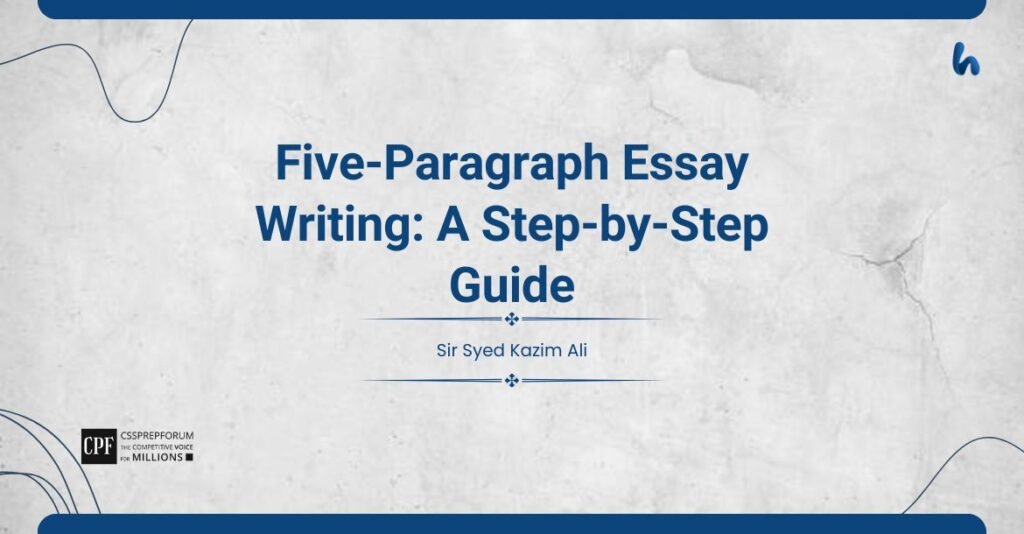
The Essay Begins Below!
Pakistan’s economy is facing one of its most severe crises in history, with inflation surpassing 30% in 2023 and foreign reserves reaching dangerously low levels. The country struggles with weak economic policies, poor resource management, and growing dependence on external loans, further exacerbating financial instability. Additionally, rising trade deficits, mounting external debt, energy shortages, and persistent political instability have worsened the situation, pushing millions into economic hardship. According to the State Bank of Pakistan (2023), the country’s trade deficit reached $37 billion, while external debt exceeded $125 billion, highlighting the scale of the crisis. However, effective policy reforms, investment in key sectors, and political stability can provide a pathway to recovery. Addressing these challenges is essential for restoring economic stability and ensuring long-term growth.
One of the primary causes of Pakistan’s economic crisis is its large trade deficit and mounting external debt, both of which have severely weakened financial stability. Pakistan has long relied on imports to meet its industrial and consumer needs, while its exports remain limited to a few sectors like textiles and agriculture. This imbalance has created a massive trade deficit, which reached $37 billion in 2023 (State Bank of Pakistan, 2023). The country’s failure to diversify exports and promote local industries has led to excessive dependence on foreign goods, draining foreign reserves. Additionally, Pakistan’s external debt exceeded $125 billion in 2023, forcing the government to rely on international loans and bailout packages, according to the State Bank of Pakistan, 2024. The continuous borrowing has increased debt servicing costs, diverting national resources away from development projects. If these economic imbalances persist, Pakistan will remain vulnerable to financial crises, struggling to sustain long-term growth.
In addition to trade imbalances, Pakistan’s energy crisis and political instability have further damaged the economy, reducing productivity and discouraging investment. A weak and unreliable power sector has significantly hurt industrial output, making it difficult for businesses to operate efficiently. Pakistan loses 2-3% of its GDP annually due to power outages, which disrupt manufacturing and export industries. With frequent electricity shortages, businesses face higher production costs, and many factories are forced to shut down, leading to widespread job losses. Alongside energy shortages, political instability has worsened investor confidence, slowing economic recovery. Pakistan has experienced frequent government changes, inconsistent policies, and civil unrest, making long-term economic planning difficult. As a result, according to the Pakistan Bureau of Statistics, Foreign Direct Investment (FDI) in Pakistan dropped by 30% in 2023 due to policy uncertainty. When investors lack confidence in a stable political and economic environment, they hesitate to invest in large-scale projects, further weakening the economy. Without addressing these challenges, Pakistan’s economic crisis will continue to deepen, pushing businesses and investors away.
To overcome the economic crisis, Pakistan must implement strong governance reforms, reduce trade deficits, invest in renewable energy, and ensure political stability. First, tackling corruption and financial mismanagement is crucial. According to the World Bank (2022), countries with strong governance attract 20-30% more foreign investment, as transparent policies restore investor confidence. Second, boosting exports and reducing trade deficits through industrial expansion and local manufacturing can reduce Pakistan’s reliance on imports. The International Monetary Fund (IMF, 2022) reports that economies promoting local industries see a 10-15% decrease in trade deficits annually. Additionally, investing in renewable energy solutions like solar and wind power can reduce Pakistan’s energy dependence and improve industrial productivity. The World Energy Report (2023) states that solar and wind energy costs have dropped by 80% over the last decade, making them affordable alternatives. Finally, ensuring political stability and policy consistency is essential for long-term growth. The OECD (2022) found that economies with stable leadership experience 3-5% higher GDP growth due to investor confidence. By focusing on these solutions, Pakistan can strengthen its economy, attract investment, and ensure sustainable financial stability.
In conclusion, Pakistan’s economic crisis results from persistent trade deficits, mounting external debt, energy shortages, and political instability, all of which have weakened financial stability. With a $37 billion trade deficit, external debt exceeding $125 billion, and frequent power outages reducing GDP by 2-3% annually, the economy continues to struggle (State Bank of Pakistan, 2023; World Bank, 2022). Additionally, a 30% decline in Foreign Direct Investment (FDI) due to political uncertainty has further stalled growth (Pakistan Bureau of Statistics, 2023). However, implementing governance reforms, boosting exports, investing in renewable energy, and ensuring political stability can pave the way for recovery. Without immediate action, Pakistan risks prolonged economic stagnation, but strategic reforms can lead the country toward long-term stability and growth.
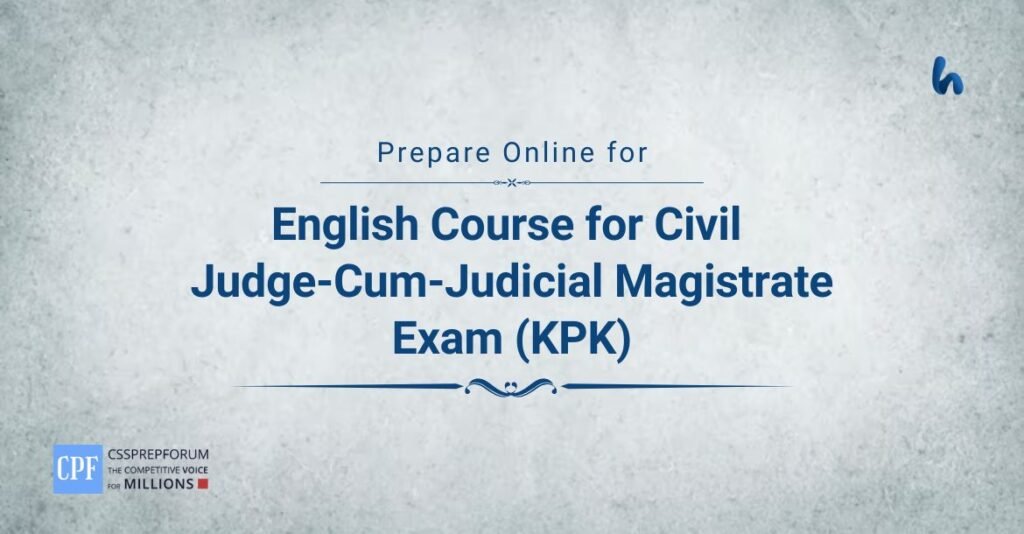
Click on Any to Start Reading
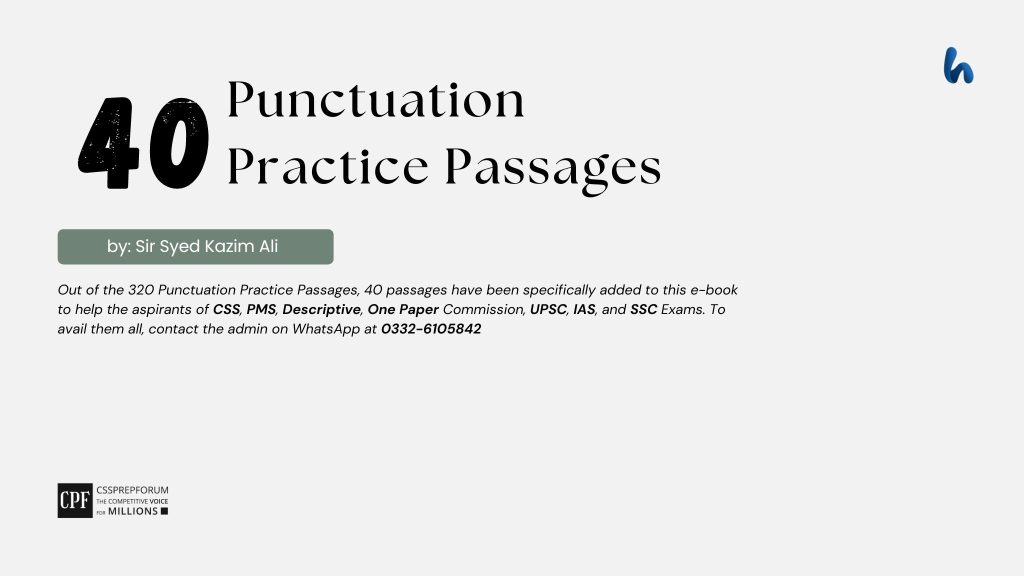


FAQs About Sir Syed Kazim Ali

CSS Solved Past Papers’ Essays
Looking for the last ten years of CSS and PMS Solved Essays and want to know how Sir Kazim’s students write and score the highest marks in the essays’ papers? Then, click on the CSS Solved Essays to start reading them.
CSS Solved Essays
CSS Solved General Science & Ability Past Papers
Want to read the last ten years’ General Science & Ability Solved Past Papers to learn how to attempt them and to score high? Let’s click on the link below to read them all freely. All past papers have been solved by Miss Iqra Ali & Dr Nishat Baloch, Pakistan’s top CSS GSA coach having the highest score of their students. General Science & Ability Solved Past Papers

